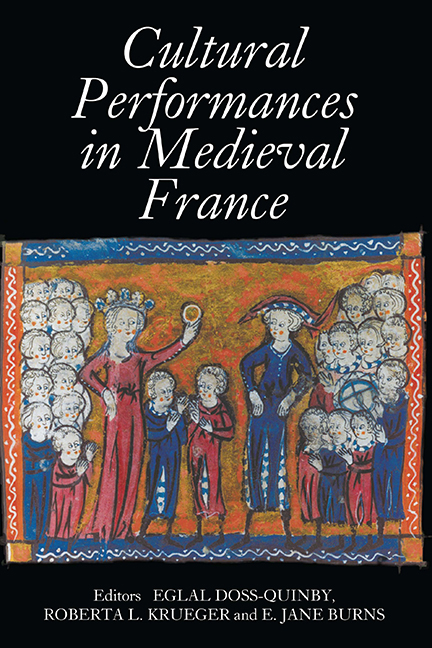Book contents
- Frontmatter
- Contents
- List of Illustrations
- Contributors
- Introduction
- Nancy Freeman Regalado, Curriculum Vitae
- PART I POETIC AND MUSICAL PERFORMANCES
- PART II PERFORMING SEXUAL AND SOCIAL IDENTITIES
- Intimate Performance: An Ivory Writing Tablet Cover at The Cloisters
- A Cultural Performance in Silk: Sebelinne's aumousniere in the Dit de l'Empereur Constant
- Acting Like a Man: Performing Gender in Tristan de Nanteuil
- Amorous Performances: The Aventure de l'espee vermeille in Perceforest
- Historicizing Performance: The Case of the Jeu de Robin et Marion
- The Protean Performer: Defining Minstrel Identity in Tristan Narratives
- PART III DEVOTIONAL PRACTICE AND TEXTUAL PERFORMANCE
- PART IV PERSUASIVE PERFORMANCES
- PART V RE–ENACTMENTS AND LEGACIES
- Tabula Gratulatoria
- Tabula Gratulatoria
Intimate Performance: An Ivory Writing Tablet Cover at The Cloisters
from PART II - PERFORMING SEXUAL AND SOCIAL IDENTITIES
Published online by Cambridge University Press: 24 October 2017
- Frontmatter
- Contents
- List of Illustrations
- Contributors
- Introduction
- Nancy Freeman Regalado, Curriculum Vitae
- PART I POETIC AND MUSICAL PERFORMANCES
- PART II PERFORMING SEXUAL AND SOCIAL IDENTITIES
- Intimate Performance: An Ivory Writing Tablet Cover at The Cloisters
- A Cultural Performance in Silk: Sebelinne's aumousniere in the Dit de l'Empereur Constant
- Acting Like a Man: Performing Gender in Tristan de Nanteuil
- Amorous Performances: The Aventure de l'espee vermeille in Perceforest
- Historicizing Performance: The Case of the Jeu de Robin et Marion
- The Protean Performer: Defining Minstrel Identity in Tristan Narratives
- PART III DEVOTIONAL PRACTICE AND TEXTUAL PERFORMANCE
- PART IV PERSUASIVE PERFORMANCES
- PART V RE–ENACTMENTS AND LEGACIES
- Tabula Gratulatoria
- Tabula Gratulatoria
Summary
… cilz est folz qui fait message
Dont on a courrous ou damage,
Especialment en amours.
Machaut, Le Livre du Voir DitNancy Regalado has devoted her career to one of the most important chapters in the history of writing in the West, the centuries between 1100 and 1500, which witnessed the rise of vernacular culture. As the use of writing expanded from ecclesiastical precincts ruled by Latin into courts and towns, with their common tongues, the very conception of writing – who could write, what could be written, how texts should look, how they should be transmitted, who could have access to them – underwent radical transformations. Nancy's work has reminded us time and again that while texts are crucial when we study the role and perception of writing in the Middle Ages, they are far from the only phenomena we may interrogate. Illumination, mise en page, compilation, social context, and performance practice also inform us about what it meant to write during an age when the vernacular “flood[ed] almost every discursive space,” when “writing … vault[ed] from song to book to print.”
In the spirit of interdisciplinary inquiry represented by Nancy's work, this essay examines what an exceptional object may tell us about perceptions of vernacular writing in a period she knows well, the first half of the fourteenth century. In 2003, The Cloisters acquired an ivory plaque measuring 9.3 x 5.9 cm that was produced between 1325 and 1350, most likely in Paris. The museum presents this object as the cover for a set of ivory writing tablets. Luxury instruments produced from antiquity until the sixteenth century, such tablets were rectangular plaques of ivory hollowed out and filled with wax. The plaques were attached by cords run through a single or multiple holes drilled in the ivory. The wax was impressed with a stylus to make characters and could be wiped to reacquire a smooth, blank surface. From the thirteenth to fifteenth centuries in France, the tablets holding wax were often sandwiched between two exterior covers carved with scenes of secular pastimes or literary episodes relating to courtship.
The Cloisters ivory appears to be such a cover because it is the same size as extant examples that accompany writing tablets, and because a hole near the upper frame would allow for a cord to attach this plaque to wax-filled ones.
- Type
- Chapter
- Information
- Cultural Performances in Medieval FranceEssays in Honor of Nancy Freeman Regalado, pp. 57 - 70Publisher: Boydell & BrewerPrint publication year: 2007



